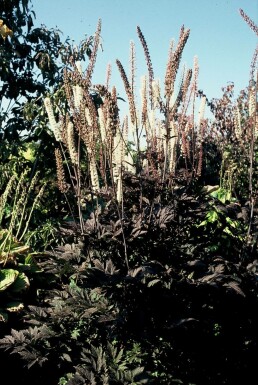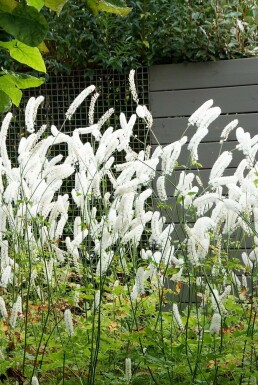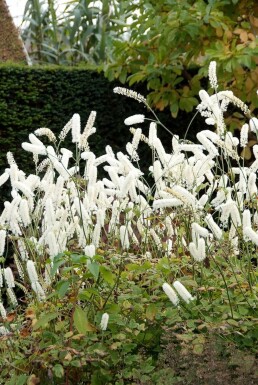
150cm



Updated on 10 September 2025
We regret to inform you that we are currently unable to ship orders to the United Kingdom. We anticipate being able to resume shipments at the beginning of 2026.
Cimicifuga blooms in autumn, adding elegance to shade gardens with tall, fragrant flower spikes. Ideal for woodland gardens, it contrasts beautifully with ferns and hostas. This structural plant attracts bees and moths, thriving in partial shade while enhancing garden biodiversity.

150cm





150cm


Cimicifuga brings a striking visual element to any garden with its tall flower spikes. These white or creamy blooms create a sense of height and drama in late summer and autumn. Its large hand-shaped leaves provide a beautiful contrast with ferns and hostas. Perfect for adding structure to a woodland garden or shaded border, Cimicifuga's fragrant autumn blooms captivate the senses. As a tall scented perennial, it thrives in partial shade, making it an ideal choice for those looking to enhance their garden's appeal. Discover how this shade perennial can transform your garden's aesthetic and enjoy the fragrant plumes it offers.
Cimicifuga, also known as black cohosh, is a tall perennial plant that thrives in shaded areas. It is part of the Ranunculaceae family and is appreciated for its aromatic inflorescence which attracts moths and pollinators. Commonly referred to as Bugbane or Actaea shrub, Cimicifuga grows slowly and prefers moisture-rich environments, making it ideal for shaded borders or forest edges. Originally found in North America and East Asia, this plant can also be a beautiful addition to gardens, where it can serve as a specimen or blend into natural settings. Its historical use as a medicinal herb highlights its importance, with records of black cohosh being used to drive away insects and for its symbolism of defense and femininity. The Latin name 'cimex' means insect and 'fugare' means to drive away, reflecting its traditional applications. The lifecycle of Cimicifuga involves it being a shade-loving perennial that blooms in autumn. It is a wonderful choice for those looking to buy Cimicifuga bare root in the UK or as one of the tall perennials for shade, offering beauty and ecological benefits. Its presence in gardens supports biodiversity by attracting bees and other pollinators.
The leaves of Cimicifuga are pinnate and finely divided, resembling ferns. They appear in a range of colours from dark green to purple-green, and even almost black. This plant's large leaves thrive in filtered light, making it ideal for shaded areas. In winter, Cimicifuga is a hardy plant, tolerating temperatures as low as -34°C to -23°C. It is well-suited for USDA zones 4 to 6. Its robust nature against frost is influenced by its ability to withstand shade and adapt to various soil conditions. Cimicifuga remains green through winter, thanks to its evergreen nature, and continues to be a garden feature all year round. Climate and location play significant roles in its adaptability, ensuring it keeps its foliage despite seasonal changes. Cimicifuga is also remarkably heat and drought tolerant. Its strong root system allows it to access deep soil moisture, and the leaf structure, coupled with any waxy coating, helps retain water. This plant is safe for gardens, posing no toxicity risk to children or pets. Cimicifuga contributes positively to biodiversity by attracting moths and providing food and habitat for various species. Its long blooming period, from late summer to autumn, supports ecosystems and enhances garden health. Its fragrant flowers brighten the garden and offer a welcoming environment for wildlife.
Cimicifuga is a great choice for gardens with partial shade. Known for its tall spikes and fragrant blooms, it adds both vertical interest and a lovely scent. Here are some ways to use Cimicifuga effectively in the garden:
Cimicifuga is a standout choice for a woodland garden or shade border. Pair this elegant plant with Hosta for striking leaf contrast. The broad leaves of Hosta highlight the feathery plumes of Cimicifuga. Astilbe, with its vibrant colours, also complements Cimicifuga’s graceful spikes. Consider adding Thalictrum, which mirrors the delicate structure of Cimicifuga. Rodgersia and Asplenium provide additional texture and lushness to the garden. These combinations work well because Cimicifuga’s fragrant plumes add a lovely aroma to the garden, especially in autumn. Moreover, its height brings a structural element, balancing shorter plants like ferns and hostas. Cimicifuga flowers fragrantly in the shade and pairs beautifully with other tall border plants. Each of these plants thrives in partial shade, offering a harmonious and serene garden scene. Choosing the right companions enhances the beauty and fragrance of Cimicifuga, ensuring a visually appealing and aromatic garden space.
Cimicifuga thrives in partial to full shade, requiring at least four hours of sunlight daily. It loves shady, cool spots and handles winter well with its large leaves adapting to filtered light. Protect from strong winds by planting near sturdy shrubs or walls. A humus-rich, acidic to neutral soil is ideal. This tall scented perennial benefits from well-drained earth and regular fertilising for optimal growth. Cimicifuga prefers moist soil; consistent watering maintains its health, especially in windy conditions. The pH level should be mildly acidic to neutral, ensuring nutrients are absorbed effectively. Consider these needs to cultivate a flourishing Actaea shrub or autumn tall flower in the garden.
Cimicifuga is best planted in spring or early autumn, in a garden area with shade or partial shade. The plant prefers nutrient-rich, humus-rich, and moisture-retentive soil. When planting Cimicifuga, ensure that it is sheltered from the wind to help it thrive. Enrich the soil with compost and keep it from drying out. It fits well at woodland edges or shady borders. The planting distance for Cimicifuga depends on several factors. Consider the plant variety and size at planting, growth speed, and the number of plants per square metre. Typically, the plant information page provides guidance on how many plants are needed per metre or square metre. For proper ground preparation, use Heijnen planting soil to enhance growth. Dig a hole suitable for the plant's root ball, and ensure the soil is loose and well-draining. After planting, water Cimicifuga thoroughly and apply a layer of mulch to retain soil moisture. Regular watering and fertilising will support its growth. It thrives in acid to neutral, humus-rich forest soil, loving shady, cool spots, making it a shade perennial with fragrant plumes.
Cimicifuga, or black cohosh, is a stunning perennial known for its tall, elegant blooms in late summer and autumn. Proper care ensures its beauty and health in the garden. Here are some essential tips for maintaining and caring for this unique plant.
Cimicifuga is a stunning perennial that offers tall flower spikes with fragrant plumes. Blooming in autumn, its flowers are usually white or cream, adding elegance to shaded areas of the garden. The foliage of Cimicifuga is another highlight, showcasing dark green to almost black leaves. These leaves not only provide a striking contrast but also enhance the visual appeal of shade borders and woodland gardens. Cimicifuga is a valuable plant for wildlife, attracting bees and moths with its scent. Its upright growth and bushy habit make it an excellent structural plant. In autumn, it offers a beautiful display with its flowering spikes that stand out in shaded conditions. The plant is perfect for creating leaf contrast with ferns and hostas, thriving in moist and shady environments. Cimicifuga blooms in fragrant plumes and thrives as a shade garden plant. It serves as a late-season bloomer, providing interest when many other plants have faded. As a shade perennial, it is also known as bugbane and black cohosh, admired for being bee and moth friendly, adding both beauty and ecological value to any garden.
The Cimicifuga, also known as black cohosh or bugbane, is a tall scented perennial that thrives in shaded gardens. Known for its medicinal history and striking differences with Astilbe, this plant adds both beauty and height to any garden. Blooming from late summer to autumn, Cimicifuga is perfect for those looking to grow a shade plant with fragrant flowers.
These popular and much-used varieties of Cimicifuga can be ordered online at Heijnen, providing an excellent selection for any shaded garden space.
Cimicifuga is a valued plant for gardens, known for its beauty and resilience. It's a favourite among gardeners who want to add unique features to their outdoor space. Here are some benefits and drawbacks of planting Cimicifuga:
Advantages:
Disadvantages:
Proper soil preparation, suitable planting location, and adequate care, including timely fertilisation, can reduce the risk of pests and diseases. Regular maintenance ensures the best growth and bloom of Cimicifuga (black cohosh).
Cimicifuga is a wonderful choice for any garden, especially a woodland garden or a shade border. Its fragrant autumn blooms stand out, adding beauty and structure. When planning to buy Cimicifuga, consider its benefits. This plant is shade-tolerant and attracts bees and moths, making it both functional and beautiful for gardeners who appreciate wildlife. With its late flowering period, Cimicifuga ensures that the garden stays vibrant from late summer to autumn. It's perfect for those looking for tall perennials for shade. Cimicifuga is also known for its medicinal history and plays an essential role in gardens where differences with Astilbe are appreciated. At Heijnen, buying bare root Cimicifuga in the UK is made easy, ensuring high-quality plants for any garden. Whether paired with ferns or hostas, it offers a striking contrast in the garden's shade areas. Buy Cimicifuga (Bugbane) from Heijnen and add dramatic height and fragrance to your shade garden with this striking autumn bloomer.
We would like to provide some tips on how to plant and care for a Cimicifuga. By following these tips, you can be sure to enjoy your Cimicifuga for a long time.
Cimicifuga thrives in shady, cool spots, making it ideal for a woodland or shaded border. It prefers acidic to neutral, humus-rich forest soil. This type of soil provides essential nutrients and good drainage, ensuring healthy growth. Place in partial to full shade, allowing for at least 4 hours of sunlight daily. The right location enhances its growth, leading to richer blooms and healthier foliage. Cimicifuga is a hardy plant, with large leaves that utilise filtered light, and thrives in moist, well-drained soil. It can adapt to different garden designs, whether as a structural plant in a natural garden or for contrast in shade borders. Ensure moist conditions, especially when planted in spring or early autumn. The correct standplaats is crucial for its development, promoting resilience and vibrant black cohosh flowers in autumn.
Preparing the soil is crucial before planting Cimicifuga. Begin by enriching the soil with compost, making sure it's well-mixed to enhance both nutrients and water retention. Good soil preparation helps water reach the plant roots efficiently. Cimicifuga thrives in soil that is acidic to neutral and rich in organic material. It's important to plant in spring or early autumn, particularly in shady or partially shaded areas. Pot-grown plants can be planted year-round, avoiding frosty periods. For those planted with burlap intact, the best times are spring or autumn. After planting, providing water is essential until the roots are well-established. The plant size determines how many Cimicifuga can be planted per square metre. Caring for these plants includes ensuring the soil remains moist and not transplanting them once they are settled.
Fertilising Cimicifuga is key for healthy growth and vibrant blooms. By providing nutrients, the plant grows stronger and produces more flowers. Using organic fertiliser from Heijnen ensures rich blossoms and vitality. For black cohosh, apply fertiliser twice a year. Early spring is ideal for the first feeding, and a light feeding can benefit during flowering in summer. The amount of fertiliser depends on the plant's size; larger plants need more. Always ensure the fertiliser is watered in, as nutrients are absorbed only once dissolved in the soil. If dry conditions persist, water the garden to activate the nutrients. This practice enhances the health and beauty of the Cimicifuga.
Cimicifuga needs careful pruning for healthy growth. The plant benefits from pruning as it encourages new growth and keeps it tidy. It is best to prune in early spring, around March. This is when old stems and leaves should be removed. Regular pruning helps maintain the plant's shape and promotes vigorous blooms. Use sharp secateurs for clean cuts and to minimise damage. High-quality tools are important to ensure precise pruning and to keep the plant in good condition. Cimicifuga prefers cool, humus-rich soil, which supports its growth after pruning. The best advice is to prune to the base, as this allows for clean regrowth. Take care when cleaning up in spring, as Cimicifuga is slow to sprout. Regular maintenance ensures the Cimicifuga, including black cohosh, thrives beautifully in the garden.
Cimicifuga thrives in evenly moist, rich soil and struggles when left dry, particularly in summer. It's important to water new Cimicifuga plants regularly to help them establish strong roots. Once rooted, water is only essential during prolonged dry spells. A deep watering is more beneficial than frequent light waterings, as it encourages the roots to grow deeper. The best time for watering is early morning or late afternoon to reduce evaporation. Check soil moisture to ensure Cimicifuga truly needs water. Excess water must drain away to prevent root rot, whether planted in the ground or in a pot. Drip irrigation systems perform better once the plant is established, but during the initial phase, additional watering by hand is necessary. Cimicifuga does not handle drought well, so regular attention to watering helps maintain its health.
Cimicifuga, known for its tall flower spikes and fragrant white or pink blooms, adds beauty to the garden. It's a shade-tolerant plant, making it ideal for areas with less sunlight. Its flowers attract moths and bees, enhancing the garden's ecological value. Historically, Cimicifuga was used for its symbolic defence and femininity. Despite its insect-repellent name, it's safe for children and pets. Known as black cohosh, it blooms late, providing structure and fragrance to your outdoor space.
Dividing Cimicifuga is essential for keeping the plant healthy and vibrant. It prevents overcrowding and gives new life to the garden. Dividing every three to four years helps maintain its beauty. This process involves digging up the plant, removing older parts, and replanting the younger sections. The best time to divide is in autumn, although spring is also suitable. Use a sharp spade or garden fork to carefully separate the root clumps. Dividing black cohosh encourages new growth and ensures that the plant thrives. Remember to water the newly planted sections well to help them establish. This simple task will enhance the garden by promoting healthy growth.
Black cohosh is known for its tall flower spikes and fragrant white flowers, blooming in late summer to autumn. This shade-tolerant perennial is perfect for woodland gardens, adding structure and contrast with ferns and hostas. Its dark green to purple-green leaves offer visual interest. Ideal for attracting pollinators, it serves as a medicinal herb. Buy Cimicifuga (Bugbane) from Heijnen and enhance your garden's allure.
